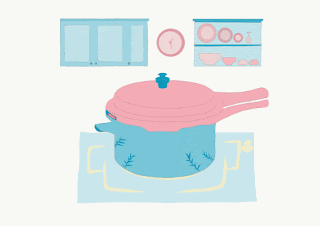How Pressure Cookers Cook Faster: The Science of Gas Laws & Vapor Pressure
Pressure cookers can reduce cooking time by up to 70% by manipulating the physics of vapor pressure and gas laws. This remarkable kitchen tool creates a high-pressure environment that raises water's boiling point, allowing food to cook at higher temperatures. Let's explore the fascinating science behind this cooking revolution.
The Physics Behind Pressure Cooking
Pressure cookers work by creating a sealed environment where two key physics principles interact:
- Vapor Pressure: As water heats, molecules escape as vapor, creating pressure. In a sealed cooker, this pressure increases dramatically.
- Gay-Lussac's Law: Pressure and temperature are directly proportional in a closed system (P ∝ T). Increased pressure raises water's boiling point above 100°C (212°F).
At sea level, water normally boils at 100°C (212°F). In a typical pressure cooker reaching 15 psi (pounds per square inch), the boiling point rises to about 121°C (250°F), dramatically accelerating cooking.
Key Scientific Principles
Vapor Pressure Explained
Vapor pressure is the pressure exerted by a vapor in equilibrium with its liquid phase. As temperature increases, more liquid molecules have enough energy to escape into the gas phase, increasing vapor pressure. In a pressure cooker, this vapor is trapped, building pressure.
Gas Laws in Action
Three gas laws govern pressure cooker operation:
- Gay-Lussac's Law: P ∝ T (at constant volume)
- Boyle's Law: P ∝ 1/V (at constant temperature)
- Combined Gas Law: PV/T = constant
Applications and Usage
Understanding these principles enables various applications:
- Home Cooking: Cook tough cuts of meat in 1/3 the normal time while retaining moisture
- Canning: Achieve temperatures high enough for safe sterilization
- High-Altitude Cooking: Compensate for lower atmospheric pressure at elevation
- Commercial Kitchens: Increase throughput with faster cooking times
- Energy Efficiency: Use 50-70% less energy than conventional cooking methods
Advantages of Pressure Cooking
- 70% faster cooking times
- Energy efficient (uses less fuel/electricity)
- Preserves more nutrients than boiling
- Tenderizes tough cuts of meat
- Reduces kitchen heat and moisture
Disadvantages of Pressure Cooking
- Requires learning proper techniques
- Safety concerns if misused
- Limited browning/caramelization
- Can overcook delicate foods
- Requires monitoring pressure levels
Pressure Cooker Simulation
Adjust the heat to see how it affects internal pressure and temperature:
Pressure: 1 atm (14.7 psi)
No heat applied - water at normal boiling point
Frequently Asked Questions
Pressure cookers have multiple safety features including a primary pressure valve that releases excess steam, a secondary backup valve, and often a safety plug that melts if temperature becomes dangerously high. Modern cookers are designed to maintain optimal pressure (typically 15 psi) by carefully regulating steam release.
Actually, pressure cooking often preserves more nutrients than conventional cooking methods. The shorter cooking times and reduced exposure to water help retain water-soluble vitamins (like vitamin C and B vitamins) that would otherwise leach out during boiling. However, some heat-sensitive nutrients may still degrade at higher temperatures.
At high altitudes, atmospheric pressure is lower, causing water to boil at temperatures below 100°C (212°F). This lower boiling point significantly increases cooking times. Pressure cookers compensate by creating artificial high-pressure environments that restore the boiling point to sea-level values or higher, making cooking times consistent regardless of elevation.
How to Use a Pressure Cooker Safely
- Always check that the steam release valve is clear before cooking
- Never fill more than 2/3 full (1/2 for foods that expand)
- Ensure the lid is properly locked before applying heat
- Use enough liquid (typically at least 1 cup) to generate steam
- Allow natural pressure release for delicate foods
- Clean all components, especially valves, after each use




